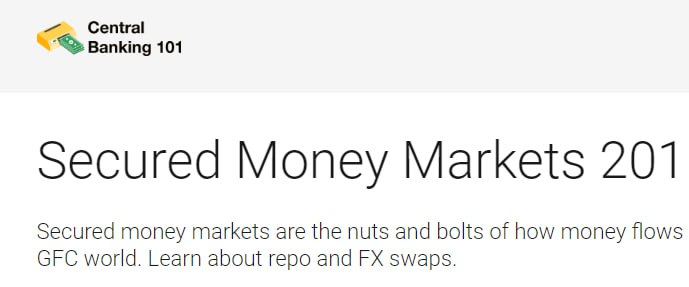Central Banking – Secured Money Markets 201
Original price was: $100.00.$17.00Current price is: $17.00.
- 24/7 Contact Support & Fast Chat
- Original Courses HD Quality
- Courses Are Updated
- Checked Download Links
- Guaraneed Safe Checkout
Description
Central Banking – Secured Money Markets 201

Secured Money Markets 201 Course: Master the Fundamentals of Repo and FX Swap Markets
Welcome to the Secured Money Markets 201 course, a comprehensive exploration of the crucial roles secured money markets—specifically the repo and FX swap markets—play in the global financial system. Designed for finance professionals and enthusiasts alike, this course delves deeply into these essential markets’ mechanics, market segments, and key participants. Understanding these markets is vital for anyone involved in financial institutions, investment strategies, or monetary policy.
The course is particularly valuable for grasping the nuances of market operations post-Global Financial Crisis (GFC) and the ongoing influence of central banks.
What Will You Learn in the Secured Money Markets 201 Course?
Understanding the Repo Market
What is the Repo Market?
The repo market, short for repurchase agreement market, is a vital component of the financial system that provides short-term borrowing and lending facilities. In a repo transaction, one party sells securities to another party with an agreement to repurchase them at a higher price on a future date. This mechanism is crucial for managing short-term funding needs and ensuring liquidity within financial institutions.
Transactional Mechanics of Repo Markets:
- How Does a Repo Transaction Work?
- In a repo transaction, the seller (borrower) transfers securities, often government bonds or other high-quality assets, to the buyer (lender). The agreement includes a repurchase date and a higher repurchase price, with the difference between the sale and repurchase prices representing the interest paid on the loan. This process is a key tool for financial institutions to manage their liquidity and short-term funding requirements.
- Collateral and Market Segments:
- Repos are typically collateralized by high-quality securities, ensuring security for the lender. The market segments include Tri-Party Repos, where a third party, usually a clearing bank, facilitates the transaction and manages the collateral, and Bilateral Repos, which are direct transactions between two parties. Additionally, repos can be classified into Specials, where specific securities are in high demand and trade at lower interest rates, and General Collateral (GC), which involves more generic securities traded at standard rates.
Key Participants in the Repo Market:
- Dealer Banks:
- Dealer banks are primary participants in the repo market, engaging in large-scale borrowing and lending. Their role is crucial in maintaining liquidity and ensuring the smooth functioning of financial markets.
- Hedge Funds and Asset Managers:
- These entities utilize repos to finance their positions and manage liquidity. By leveraging repo transactions, they can optimize their investment strategies and maintain financial flexibility.
- Central Banks:
- Central banks, including the Federal Reserve, engage in repos as part of their monetary policy operations. Through open market operations and the Standing Repo Facility (SRF), central banks manage liquidity in the banking system, ensuring financial stability and effective monetary policy implementation.
Delving into the FX Swap Market
What is the FX Swap Market?
The FX swap market involves the exchange of currencies between two parties, with an agreement to reverse the transaction at a future date at a predetermined rate. This market is essential for managing currency risk and liquidity in global financial markets, providing a mechanism for entities to obtain foreign currency funding and hedge currency exposure.
Transactional Mechanics of FX Swaps:
- How Do FX Swaps Work?
- In an FX swap transaction, the parties exchange currencies at the spot rate and agree to reverse the transaction at a forward rate. The difference between the spot and forward rates reflects the interest rate differential between the two currencies. This mechanism helps banks and corporations manage currency risk and secure foreign currency funding.
- Market Segments:
- The FX swap market includes short-term swaps, typically from overnight to a few days, used for immediate liquidity needs, and longer-term swaps extending up to a year or more, often used for hedging long-term currency exposures.
Key Participants in the FX Swap Market:
- Commercial Banks:
- Major players in the FX swap market, commercial banks use swaps for liquidity management and currency risk hedging. Their involvement is crucial for maintaining stability in currency markets and providing liquidity.
- Central Banks:
- Central banks engage in FX swaps to influence currency markets and stabilize exchange rates. The Federal Reserve, for example, establishes swap lines with other central banks to provide liquidity in US dollars during times of market stress.
- Corporates:
- Corporations use FX swaps to manage exposure to foreign currency risk in international transactions. By leveraging these swaps, they can mitigate the impact of currency fluctuations on their financial operations.
The Fed’s Involvement in Secured Money Markets
How Does the Fed Influence the Repo Market?
The Federal Reserve plays a significant role in the repo market through open market operations and the Standing Repo Facility (SRF). These tools allow the Fed to manage liquidity in the banking system and support effective monetary policy implementation.
- Open Market Operations:
- The Fed uses repos and reverse repos to manage short-term liquidity and influence interest rates. The Fed can inject or withdraw liquidity from the financial system by engaging in these transactions, affecting overall market conditions and monetary policy.
- Standing Repo Facility (SRF):
- Introduced post-GFC, the SRF provides eligible banks with direct Fed liquidity access. This facility ensures that banks have a reliable funding source during periods of market stress, contributing to overall financial stability.
How Does the Fed Manage Currency Liquidity Through FX Swaps?
In times of financial crises or market stress, the Fed’s FX swap lines are crucial in preventing disruptions in global dollar funding. These swap lines allow the Fed to provide liquidity in US dollars to foreign central banks, which can then supply their own currencies to local banks and institutions.
- Swap Lines:
- The Fed establishes swap lines with other central banks to facilitate currency exchange and provide liquidity during periods of market strain. These arrangements are vital for maintaining stability in global financial markets and ensuring that the flow of US dollars remains uninterrupted.
- Crisis Management:
- During financial crises, the Fed’s FX swap lines play a critical role in stabilizing currency markets and preventing liquidity shortages. By offering support to foreign central banks, the Fed helps mitigate the impact of market disruptions and maintain financial stability.
Why Enroll in the Secured Money Markets 201 Course?
Comprehensive Understanding of Critical Markets:
The Secured Money Markets 201 course offers a thorough exploration of the repo and FX swap markets, providing participants with essential insights into their mechanics, segments, and key participants. This understanding is crucial for navigating the complexities of the financial system and effectively managing liquidity and currency risk.
Expertise in Central Banking Operations:
By delving into the Fed’s involvement in these markets, the course equips learners with valuable knowledge about central banking operations and their impact on financial stability. This expertise is beneficial for anyone involved in monetary policy, financial regulation, or market analysis.
Practical Application and Real-World Relevance:
The course’s focus on practical application ensures that participants can translate their learning into real-world scenarios. Whether you’re a finance professional, policymaker, or academic, the insights gained from this course will enhance your ability to understand and navigate the financial system.
Enhanced Career Opportunities:
A comprehensive understanding of secured money markets and central banking operations can significantly enhance career prospects in finance, economics, and related fields. The Secured Money Markets 201 course provides the knowledge and skills needed to excel in these areas and advance your career.
Conclusion
The Secured Money Markets 201 course offers a deep dive into the critical components of the financial system, focusing on the repo and FX swap markets. With its detailed exploration of transactional mechanics, market segments, key participants, and the role of the Federal Reserve, this course equips learners with a comprehensive understanding of these essential markets. Whether you’re looking to enhance your financial expertise, improve your career prospects, or gain valuable insights into central banking operations, the Secured Money Markets 201 course is an invaluable resource for achieving your goals.
Enroll today and gain the knowledge needed to master the intricacies of secured money markets and their role in the global financial system.









